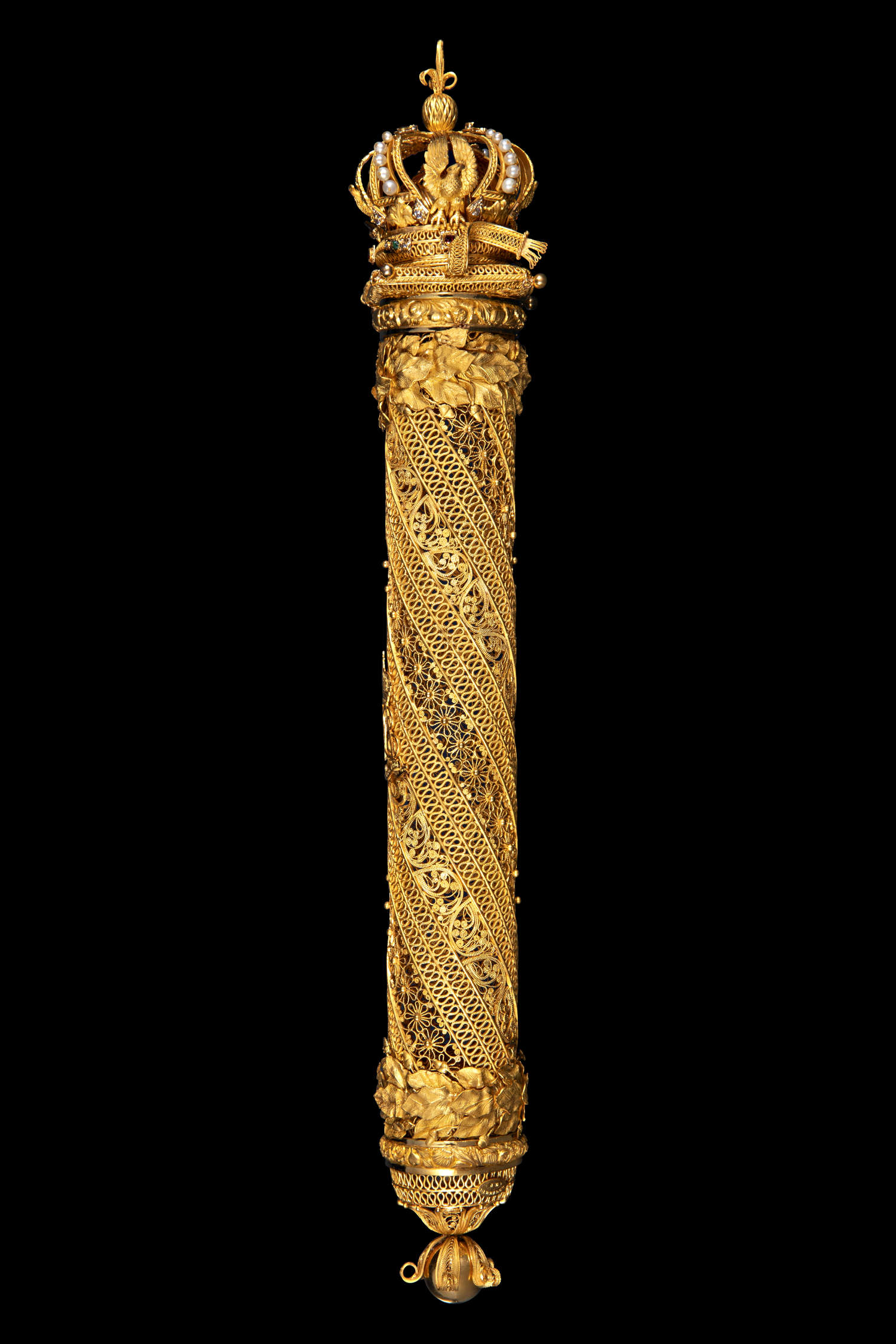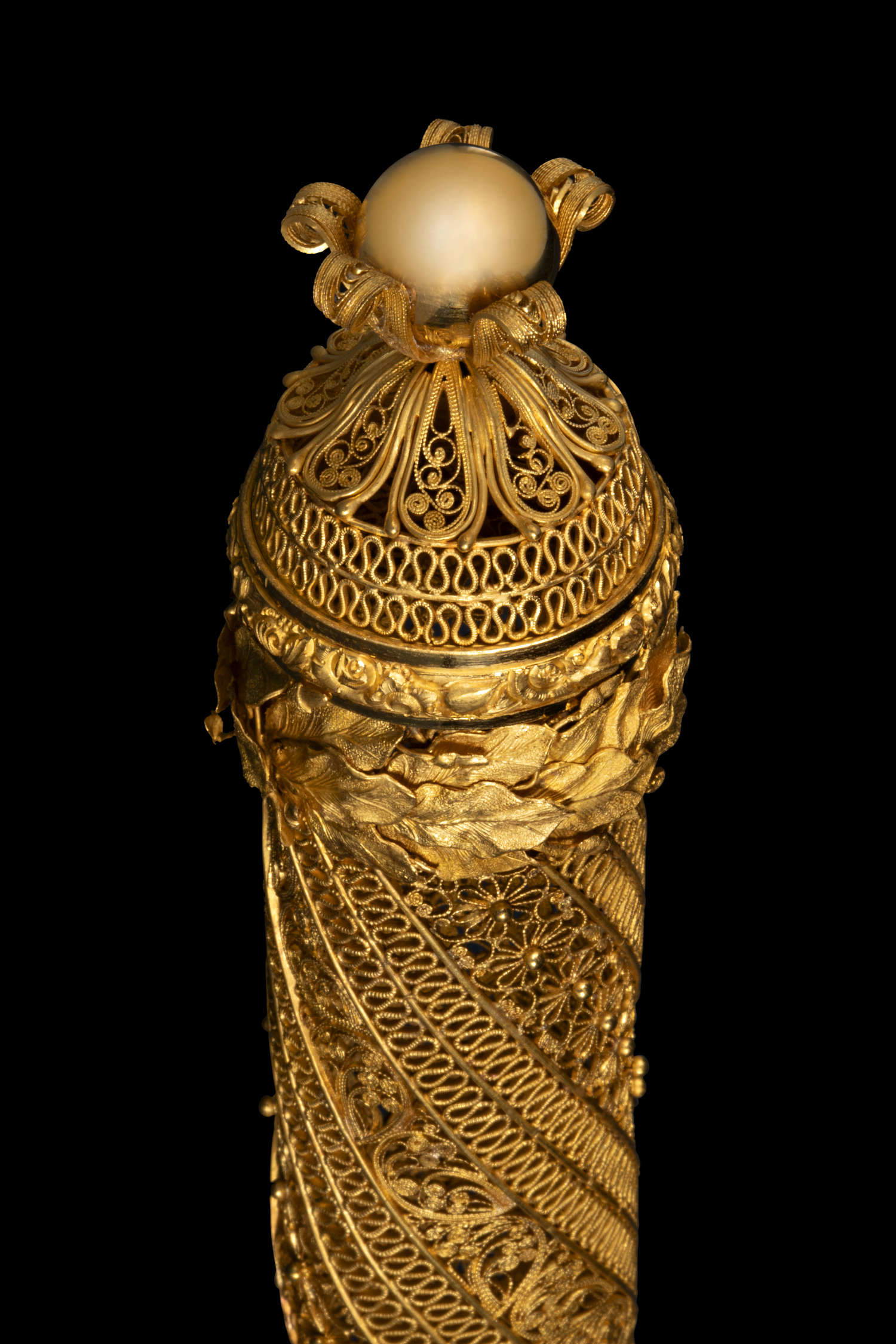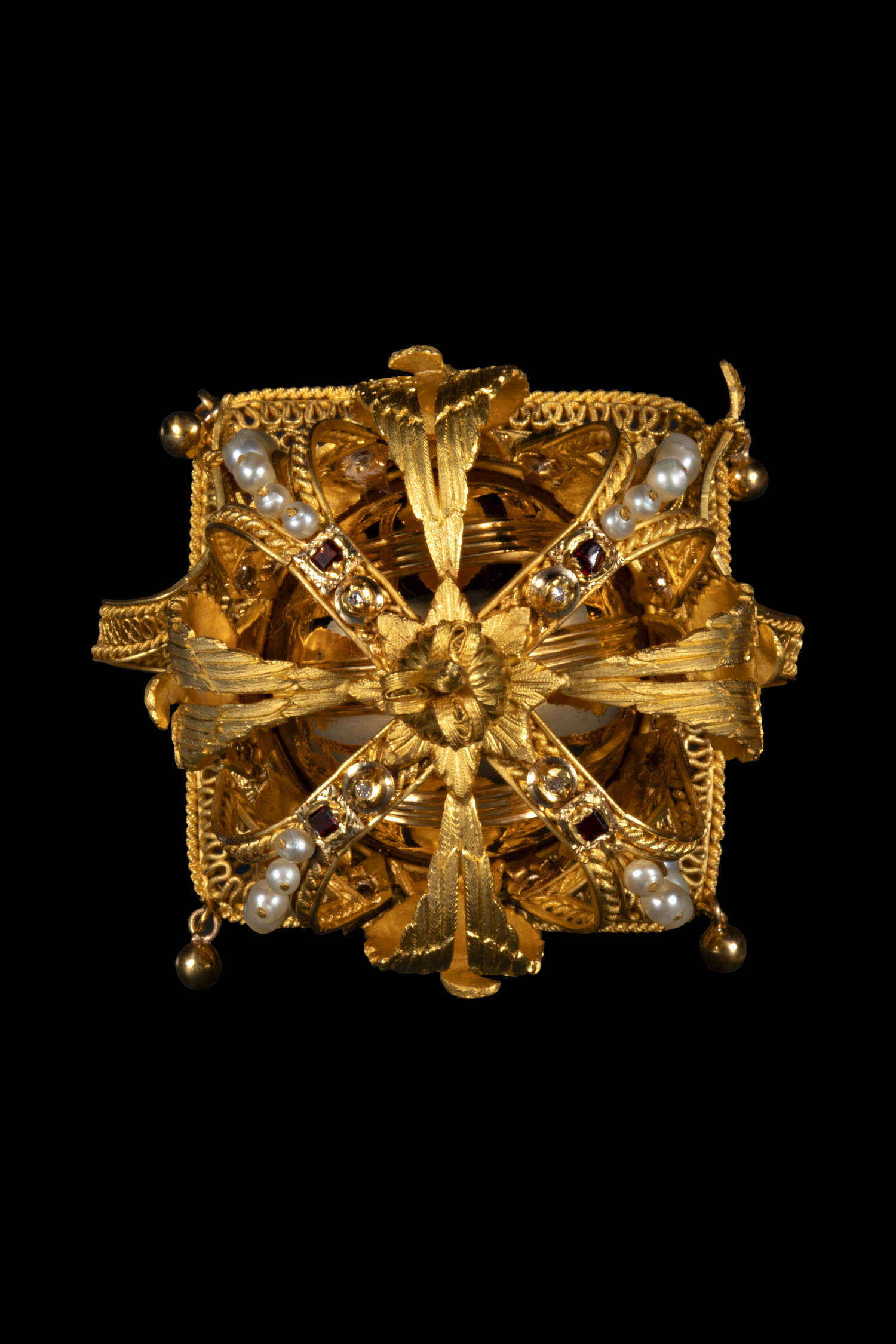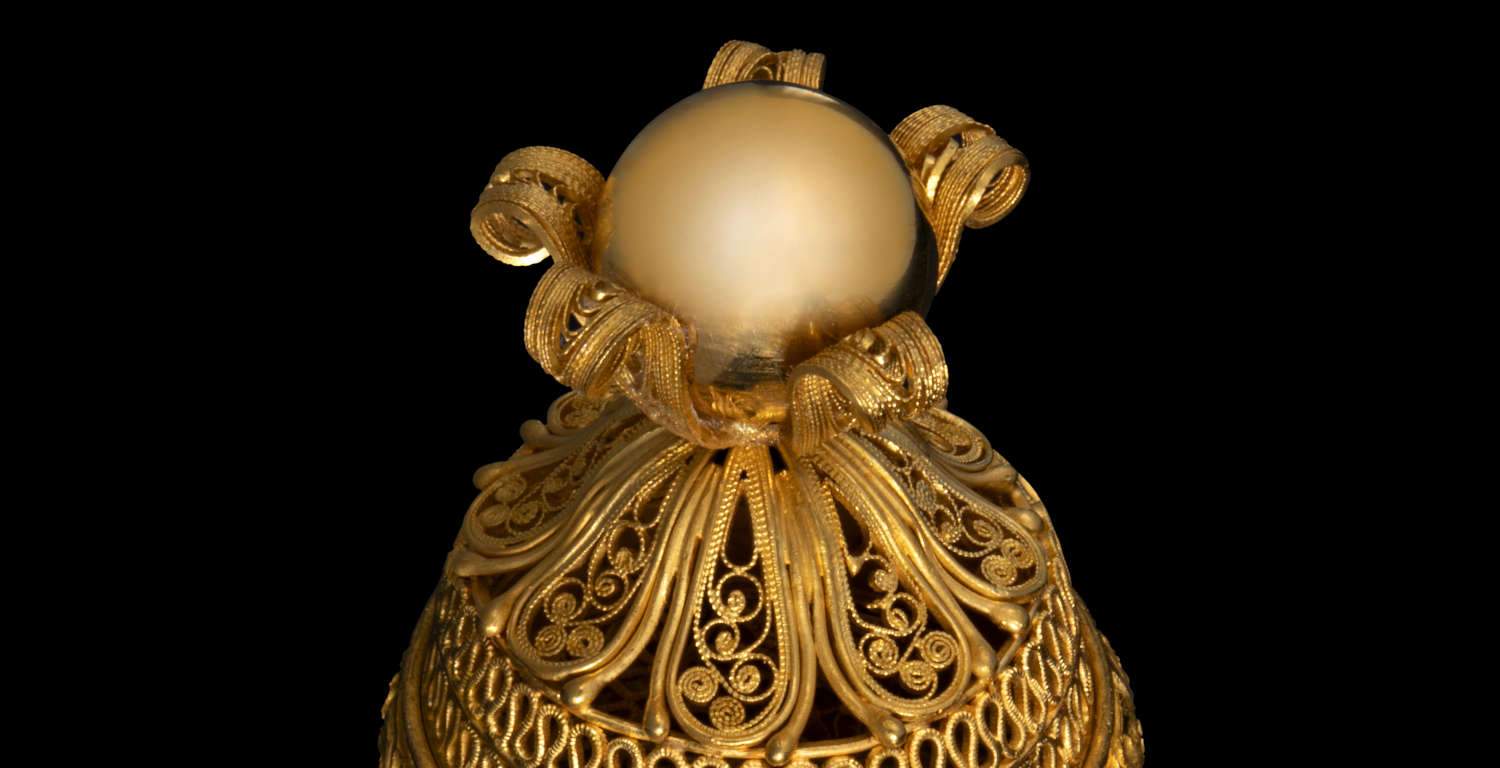Trieste, Empress Charlotte of Mexico's scepter on display at Miramare Castle
Acquired in Monte Carlo in the summer of last year as part of an auction in the Principality of Monaco by the CRTrieste Foundation, the scepter that once belonged toEmpress Charlotte of Mexico is on public display in an exhibition that started April 16 at the Historical Museum and Park of Miramare Castle in Trieste. An exhibition arrangement befitting the preciousness of the object was created for the scepter in the Salottino Orientale on the second floor of the Castle.
The scepter has great symbolic value because it represents a peculiar period of European history in the mid-19th century, which saw Trieste at the center of international geo-political events. In fact, the object was given to the newly-emperoress who arrived in Mexico together with her consort Maximilian of Habsburg precisely from Miramare, and it arrived in Europe under little-known circumstances: in fact, Charlotte’s South American sojourn was short-lived, as she was soon forced by circumstances to seek economic and military aid between France and Italy. In the course of the tragic events that involved her, the scepter ended up in the hands of her brother Leopold II King of Belgium, who years later gave it to Baron Adrien Goffinet in gratitude for his loyal services. Finally, in 2023, Baron Goffinet’s descendants decided to auction the object. The scepter of Empress Charlotte of Mexico is a 22-carat gold jewel, fully decorated in filigree and by chiseled friezes of flowers and leaves. At 34 cm long and 6 cm wide, adorned with diamonds, rubies and emeralds, it has a total weight of 418.50g. It is set on a sphere between scrolls and is surmounted by an imperial crown of gold threads, pearls and eagles with spread wings.
The tiara is set on a filigreed cushion of gold trimmings and is embellished with rubies, emeralds and diamonds set on the bezel. The ends of the scepter are adorned with finely chiseled leaves and acorns in relief. This object appears mysterious and unusual since it is both a shrine and a precious case enclosing the cartouche of dedication to the future sovereign by the city of San Juan del Rio. Another special fact is also its pediment, which represents the other lofty symbol of royalty, the imperial crown embellished with pearls and precious stones, similar to the golden crown with arches of the Mexican Empire, reproduced further down in two-dimensional form along with Charlotte’s initials. It is decorated with the monogram of the Mexican Empire wanted by Maximilian, with a ribbon underneath bearing the inscription “San Juan del Rio 1864.” On the base is a small plaque with the signature of goldsmith Jose Maria Larralde. The scepter is preserved in its original case. Proclaimed emperor of Mexico on April 10, 1864, Maximilian left aboard the Frigate Novara on April 14 of the same month for Mexico with his wife Charlotte. The new emperors landed in America at Veracruz on May 24, 1864, and then arrived in Mexico City on June 12. On May 25, while the couple was still traveling, the municipal council of the city of San Juan del Rio met and decided to take some steps to ingratiate themselves with the new rulers. A committee from the municipality of San Juan del Rio later traveled to Mexico City to confer with the empress and offer the scepter as a gift.
“I can never forget the departure from Trieste. A small orchestra played the hymns of the Austrian navy, while Carlotta and I took our places on the bow of the lance that would take us aboard the Novara, and the crowd crowded around our dear castle, joyous and festive, eager to bid us farewell.”
“We finally put out to sea, setting sail toward a radiant tomorrow, yet we could not stop ourselves from glancing again at Miramare Castle, which blurred into the coastline on the horizon. It has already become our distant home.”
The entrance to San Juan del Río was described by Maximilian himself in a letter to Carlotta dated August 20, 1864 in Santiago de Querétaro. “In the afternoon we arrived at San Juan del River, a delightful little town situated on a wonderful plain. The welcome was so cordial that it would be difficult to describe it. San Juan is a second Orizaba for its beauty, friendliness and alert spirit. Last night I had a big banquet with all the Franco-Mexican officers and more than three hundred soldiers. I wore the uniform with the cordon of the Legion of Honor. Thank God I was able to give my two toasts, to the Emperor of France and to the army. I spoke from an elevated platform, very slowly and loudly, so that the whole crowd would hear and understand well.”

 Charlotte
Charlotte Charlotte’s
Charlotte’s Charlotte’s
Charlotte’s Charlotte’s
Charlotte’sThe circumstances of the precious gift given to the Empress are described in detail by an original document that was kept inside the scepter itself, initialed by the first representative of the City Council of San Juan del Rio, Ángel M. Domínguez. The document measures about 48 cm by 21 cm. The parchment reads, “At the city of San Juan del Río, capital of the District of the same name belonging to the Department of Querétaro, on the year one thousand eight hundred and sixty-four, on the twenty-fifth day of the month of May, assembled in the council chamber of the Most Illustrious City Hall, the gentlemen composing it taking into consideration: that the establishment of the Mexican Empire is a fait accompli by virtue of the official acceptance of the throne by His Most Illustrious Majesty, Ferdinand Maximilian I, which took place in his own castle of Miramare on the tenth of April of the current year; that having His Majesty sacrificed himself for Mexico, leaving his ancient homeland and his family, it is incumbent upon every good Mexican to pay him public homage by way of gratitude, adherence and loyalty; that it is incumbent upon the Municipalities, as legitimate representatives of the Municipalities, to demonstrate directly on behalf of their representatives thelove and gratitude by which they are possessed for the benefits to which they are already indebted and for those they promise themselves for the future from the wise and enlightened government of the Monarch who rules their destinies; the Most Illustrious Municipality of San Juan del Río desires that the Sovereigns have a proof of the adherence of the said city to their August persons, and persuaded that His Majesty, the Emperor, will please and be pleased with every demonstration of love and respect for His August Bride, resolves: The city of San Juan del Río acclaims as Patroness and special Protectress His Majesty, Empress Charlotte Amalia. Inside the council chamber of said City Hall shall be hung under canopy the portraits of Their Majesties, placing at the bottom of that of Her Majesty, the Empress, the caption Carlotta Amalia, Empress of Mexico, Patroness and Protectress of the City of San Juan del Río.” Second. The main square will henceforth bear the name “Empress Square” and will be the subject of every possible beautification work, placing in the center a column crowned with a bust of Her Majesty, while in the pedestal it will have the following inscription: “To the beloved Sovereign and special Protector, Empress Charlotte Amalia, the City of San Juan del Río.” Third. There shall be established at the said city a charitable society in honor of Her Majesty, the Empress, composed of the principal Gentlewomen of the city, which shall be called the “Charitable Society of Saint Charles.” Fourth. The commission appointed for the purpose of drawing up these minutes, shall ask Their Majesties for a special audience in order to have the high honor of placing it in the royal hands of Our Sovereign Protector, while the original shall remain in the hall of the Cabildo, signed by the councilors by whom it is supplemented: Political Prefect, Manuel Domínguez; first Councilor Ramón Macotela; second Councilor Agustín R. Olloqui; third Councilor José María Sánchez; fourth Councilor Luis Ortiz; fifth Councilor Arcadio Ynarra; sixth Councilor Juan V. Legarreta; seventh Councilor Juan Macías León; eighth Councilor Jesús M. Alcántara; first Council Representative Ángel M. Domínguez; second Council Representative Miguel Silis. Secretary Venancio Romero. (Signature) First Council Representative Ángel M. Domínguez."
As a tribute to Charlotte, the scepter of San Juan del Río probably became part of her estate and so was among the precious objects Charlotte took with her on her return to Europe. After Maximilian’s death and Charlotte’s return to Belgium in 1867, at some unspecified time King Leopold II gave this object to Baron Adrien Goffinet as a reward for his services. Goffinet had been in the service of the Belgian monarchy since the 1840s, as first officer and secretary to Duke Leopold of Brabant, the future King Leopold II; the prince entrusted him with the management of his own private property and that of his wife, Maria Enrichetta, as well as the management of their archives. The sovereign’s esteem and trust were such that Goffinet was also charged with organizing Charlotte’s delicate transfer from Italy to Belgium in 1867, and in administering the empress’s personal estate. It was precisely because of this role that Baron Goffinet received as a gift the scepter that had belonged to Charlotte, which remained among the family’s possessions until it was sold at auction on July 18, 2023 at the Hotel de Ventes de Monte-Carlo (Principality of Monaco). The scepter was purchased by the CRTrieste Foundation, which gave it on loan to the Miramare Museum to be displayed in the permanent collection, in the rooms once inhabited and loved by Carlotta. Restorer Anna Collarin handled the restoration of the artifact. After an initial cleaning phase, carried out to remove metal oxidation and color alterations, the deformations were restored to restore the correct legibility of the work. In addition, the fractured portions were repositioned and glued, using acrylic adhesives and the insertion of a silk veil to ensure better support and support for the gluing. Finally, pictorial retouching was performed to soften the visual impact of some lead soldering done in previous maintenance work. The cartouche, also the original document preserved inside the scepter, likely made by machine with semi-chemical pulp was the subject of a careful restoration by Adriano Macchitella and Loredana Soranzio, which involved the removal of dust and surface deposits, the integration of gaps and the restoration of the sheet’s flatness.
“In April 2024,” said Director Contessa, “One hundred and sixty years after the departure of the archducal couple from the small harbor of Miramare Castle to Mexico, the Museum will put on display for the first time in the Oriental Drawing Room a unique object, the memory of which had been lost: the golden scepter of Charlotte of Belgium, born Coburg Gotha, who married Ferdinand Maximilian of Habsburg and became Empress of Mexico.”
“Remaining for decades in the private collection of the heirs of Adrien Goffinet, an important figure for his services to the Belgian royal household, and for his curatorship of the young empress’s substantial personal fortune, the object has returned to light thanks to a public auction and the far-sighted purchase by the CRTrieste Foundation, to whom we are grateful for the acquisition. The concession on loan,” Contessa continued said, “entails an enrichment of the Historical Museum’s collection and a further step in the knowledge of the figure of Charlotte, about whom so little we still know.”
“A precious artifact and a witness to the leading role Trieste played in the 19th century in the world historical panorama,” remarked CRTrieste Foundation President Massimo Paniccia. “Indeed, from Trieste, in April 160 years ago, the future Emperor of Mexico departed. The will of the Foundation, as an institution, is to be an engine of the socioeconomic development of the territory, also through the enhancement of its cultural and historical heritage, implementing the offer of Trieste, for the benefit of the community.”
 |
| Trieste, Empress Charlotte of Mexico's scepter on display at Miramare Castle |
Warning: the translation into English of the original Italian article was created using automatic tools. We undertake to review all articles, but we do not guarantee the total absence of inaccuracies in the translation due to the program. You can find the original by clicking on the ITA button. If you find any mistake,please contact us.



























